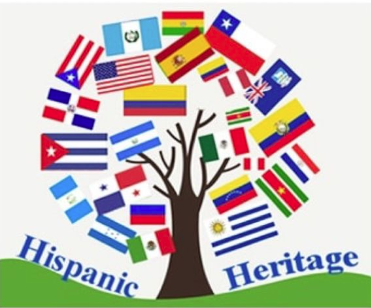
Hispano and Latino are widely used in American English for Spanish-speaking people and our descendants in the United States.
Hispanic/Latino American Demographics: This ethnic group includes any person of Cuban, Mexican, Puerto Rican, South or Central American, or other Spanish culture or origin, regardless of race. The Census Bureau estimates there were roughly 63.7 million Hispanics in the U.S. as of 2022, a new high. Latinos make up 19 percent of the nation's population. Hispanics are living and thriving in America, and we are growing every single day in the USA. #MEGA Make Español Great Again.
While Hispanic refers to Spanish speakers overall, Latino refers specifically to people of Latin American descent. descent.
The term Hispanic can also be used for the people and culture of Spain as well as Latin America. While originally the term Hispanic referred primarily to the Hispanos of New Mexico within the United States, today, organizations in the country use the term as a broad catchall to refer to persons with a historical and cultural relationship with Spain regardless of race and ethnicity. The United States Census Bureau uses Hispanic or Latino to refer to a person of Cuban, Mexican, Puerto Rican, South or Central American, or other Spanish culture or origin regardless of race and states that Hispanics or Latinos can be of any race, any ancestry, or any ethnicity.
Because of the technical distinctions involved in defining "race" vs. "ethnicity", there is confusion among the general population about the designation of Hispanic identity. Currently, the United States Census Bureau defines six race categories:
- White or Caucasian
- Black or African-American
- American Indian or Alaska Native
- Asian
- Native Hawaiian or Other Pacific Islander
- Some Other Race
According to census reports, of the above races the largest number of Hispanics or Latinos are of the White race, and the second largest number come from the Native American/American Indian race who are the indigenous people of the Americas. The inhabitants of Easter Island are Pacific Islanders and since the island belongs to Chile they are theoretically Hispanic or Latino. Because Hispanic roots are considered aligned with European ancestry in Spain, Hispanic ancestry is defined solely as an ethnic designation (similar to being Norse or Germanic). Therefore, a person of Hispanic descent is typically defined using both race and ethnicity as an identifier—i.e., Black-Hispanic, White-Hispanic, Asian-Hispanic, Amerindian-Hispanic, or "other race" Hispanic.
A 1997 notice by the U.S. Office of Management and Budget defined Hispanic or Latino persons as being "persons who trace their origin or descent to Mexico, Puerto Rico, Cuba, Central and South America, and other Spanish cultures." The United States Census uses the ethnonyms Hispanic or Latino to refer to "a person of Cuban, Mexican, Puerto Rican, South or Central American, or other Hispanic culture or origin regardless of race."
The 2010 census asked if the person was "Spanish/Hispanic/Latino". The United States Census uses the Hispanic or Latino to refer to "a person of Cuban, Mexican, Puerto Rican, South or Central American, or other Spanish culture or origin regardless of race." The Census Bureau also explains that "[o]rigin can be viewed as the heritage, nationality group, lineage, or country of birth of the person or the person's ancestors before they arrived in the United States. People who identify their origin as Hispanic, Latino, or Spanish may be of any race."
The U.S. Department of Transportation defines Hispanic as, "persons of Cuban, Mexican, Puerto Rican, Central or South American, or other Spanish culture or origin, regardless of race." This definition has been adopted by the Small Business Administration as well as by many federal, state, and municipal agencies to award government contracts to minority-owned businesses. The Congressional Hispanic Caucus and the Congressional Hispanic Conference include representatives of Spanish and Portuguese, Puerto Rican, and Mexican descent. The Hispanic Society of America is dedicated to the study of the arts and cultures of the Hispanic and Lusitania world. The Hispanic Association of Colleges and Universities, proclaimed champions of Hispanic success in higher education, is committed to Hispanic educational success in the United States, and the Hispanic and Lusitanic world.
The U.S. Equal Employment Opportunity Commission encourages any individual who believes that he or she is Hispanic to self-identify as Hispanic. The United States Department of Labor – Office of Federal Contract Compliance Programs encourages the same self-identification. As a result, individuals with origins to part of the Spanish Empire may self-identify as Hispanic, because an employer may not override an individual's self-identification.
The 1970 census was the first time that a "Hispanic" identifier was used and data was collected with the question. The definition of "Hispanic" has been modified in each successive census.
In a recent study, most Spanish speakers of Spanish or Hispanic American descent do not prefer the term Hispanic or Latino when it comes to describing their identity. Instead, they prefer to be identified by their country of origin. When asked if they have a preference for either being identified as Hispanic or Latino, the Pew study finds that "half 51 percent say they have no preference for either term."Among those who do express a preference, "'Hispanic' is preferred over 'Latino' by more than a two-to-one margin—33 percent versus 14 percent ." 21 percent prefer to be referred to simply as "Americans". A majority of 51 percent say they most often identify themselves by their family's country of origin, while 24 percent say they prefer a pan-ethnic label such as Hispanic or Latino.